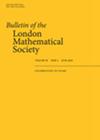On Lev's periodicity conjecture
IF 0.9
3区 数学
Q2 MATHEMATICS
引用次数: 0
Abstract
We classify the sum-free subsets of whose density exceeds . This yields a resolution of Vsevolod Lev's periodicity conjecture, which asserts that if a sum-free subset is maximal with respect to inclusion and aperiodic (in the sense that there is no non-zero vector satisfying ), then —a bound known to be optimal if , while for there are no such sets.




关于列夫的周期性猜想
我们对密度超过16 $\frac{1}{6}$的f3n ${\mathbb {F}}_3^n$的无和子集进行了分类。这就解决了列夫的周期性猜想,它断言,如果一个无和的子集a≠F 3n ${A\subseteq {\mathbb {F}}_3^n}$在包含和非周期(即不存在非零向量v $v$满足?A + v = A $A+v=A$),然后| A |≥1 2 (3 n−1)+ 1) $|A|\leqslant \frac{1}{2}(3^{n-1}+1)$ -当n≠2时已知的最优界$n\ne 2$,而对于n = 2 $n=2$,不存在这样的集合。
本文章由计算机程序翻译,如有差异,请以英文原文为准。
求助全文
约1分钟内获得全文
求助全文
来源期刊
CiteScore
1.90
自引率
0.00%
发文量
198
审稿时长
4-8 weeks
期刊介绍:
Published by Oxford University Press prior to January 2017: http://blms.oxfordjournals.org/

 求助内容:
求助内容: 应助结果提醒方式:
应助结果提醒方式:


